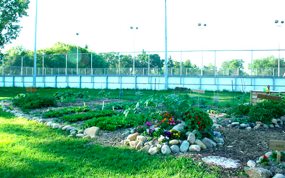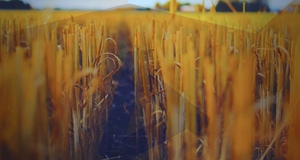From Earth Common Journal VOL. 3 NO. 1Roots, Tendrils, Sprouts and Shoots: A Case Study of Parkallen's Community Garden, a Permaculture Project
IN THIS ARTICLE
KEYWORDS
AbstractThe first growing season of Edmonton’s Parkallen Community Garden began in Spring 2012. We transformed an unused strip of lawn bordering our hockey rink into a loamy, thriving “edible food forest” of corn, beans, squash, kale, tomatoes, carrots, potatoes, apple trees, and mammoth sunflowers. It is unlike most community gardens in that individual plots are not tended by individual gardeners; rather, the PCG is tended communally, by the community. The garden is open and accessible to the community, always, and all are welcome there, from the toddler whose only contribution is to chomp on a snowpea and water a dandelion, to the senior who wants to plant a tree in his community that he knows will outlive him. Hundreds of Parkallen residents have planted something, admired something, or munched on something there. In its first year Parkallen’s garden won The City of Edmonton’s top community gardening award from Communities in Bloom. This article is a case study of the Parkallen Community Garden. Through the lenses and observations of the author, it details how Parkallen’s permaculture design came, literally, to fruition and how permaculture has been interpreted and how it informs our garden and our gardening community. The SeedsPassersby of the Parkallen Community Garden have remarked to me that it seemed to spring up out of nowhere. For years they would walk or drive down 65th street and find nothing at all noteworthy about the stretch of grass between the hockey rink and the sidewalk. In a city that boasts over 4,500 hectares of maintained parkland and urban green spaces (City of Edmonton), an area that could fit more than 23 of New York City’s Central Park within it (City of New York, 2013), the small length of lawn that would become the Parkallen Community Garden couldn’t be less remarkable. Then, in the summer of 2012, mammoth sunflowers sprouted upwards through the fresh, loamy soil and began to rapidly tower their massive, heavy heads upwards. They are a showy flower and they weren’t there before. Passersby did find that remarkable. Stepping down the garden path, visitor’s would find themselves in an urban “food forest” with herbs, tomatoes, corn, beans, carrots, beets, turnips, apple trees, nut and berry bushes, strawberries, kale and pumpkin plants growing in lush beds and borders where, since 1954, there was just neatly mown, ignorable grass (City of Edmonton, 2009). “Ka-boing!” is the word several observers used to describe the appearance of the Parkallen Community Garden to me in its first growing season.
Parkallen is a mature Edmonton neighbourhood originally designed by city planner Noel Dant, post-WWII, as his ideal vision of a suburban community (City of Edmonton, 2009). Old elms and ash trees canopy the wide streets. Because of Dant’s planning, traffic bypasses Parkallen if it isn’t local, or, if it is local, traffic slows down. Dant designed Parkallen using the “English Garden Model,” meaning that all the homes in the community surround a central greenspace at the heart of the community in which the community hall, school, playground, and, now, the Parkallen Communty Garden are seated (City of Edmonton, 2009). Since the 1950’s, the “green” of that central greenspace has been defined by the grass and shade trees planted and maintained by the City of Edmonton, as well as some annual and flower-beds maintained by volunteers. There’s been plenty of green in Parkallen’s “English Garden,” but none of it has been edible. In today’s metropolitan Edmonton, Parkallen is no longer a suburban, but rather an urban community. In the most recent Parkallen Community Development Plan by the City of Edmonton (circa 1994, republished in 2013), the vision statements of Parkallen’s urban planners insist on “respecting, enhancing, and strengthening Parkallen’s urban lifestyle” by promoting walking, cycling and the use of public transit. City planning task forces are committed to preserving “the area’s local character, urban lifestyle, and sense of place (City of Edmonton, 2013, p 5., emphasis mine).” During Parkallen’s shift, over the past six decades, from suburban to urban, the large, public park space has stayed central to community’s geography. The emergence of a community food garden in what is now Parkallen’s urban greenspace is certainly part of a broader trend “in food- based social movements and grass-roots initiatives around the world, from slow food to community gardens (2011, Turner, Henryks & Pearson, p. 492). In 2009, Transport Canada and the City of Edmonton showcased an eco- transportation project called Local Motion with Parkallen as the pilot community. Local Motion was “conceived as an opportunity to use a community based approach to encourage the use of ecofriendly modes of transportation (City of Edmonton, 2011).” For one month, in June of 2009, Parkallen residents were asked to use alternative transportation, i.e. alternative to cars. This project had two very significant, to the Parkallen Community Garden, results. Firstly, the community-based volunteers who worked on the municipally and federally-funded project were galvanized together as a group who shared mutual concerns and goals regarding sustainability. They formed a sub-committee of the Parkallen Community League directed by Robert Kirchner, an elected Sustainability Coordinator. “Parkallen’s Local Motion project (2009) brought together a critical mass of residents eager to work together on neighbourhood sustainability initiatives (Kirchner, 2011).” When the Local Motion project wrapped up, interest in working towards sustainability-related goals did not. Creating a community garden in Parkallen became the focus of that group, and so the figurative seeds of the PCG were planted. Through a community-wide survey initiated by the Park Redevelopment Committee (a sub-committee of the Parkallen Community League) wider-spread interest in creating a community garden was gauged in the community at- large. Secondly, the Local Motion project garnered the Parkallen Community League a “Green Award” which the Community League earmarked for the creation of a community vegetable garden (Edmonton Federation of Community Leagues, 2010). Thus, the seeds (as in the idea to create a garden) and the seed money (literally, money to buy seeds and other materials) were in place. Two years later, in the early spring of 2012, when the ground was still snow-crusted and frozen, I picked out a pack of mammoth sunflower seeds from the Sustainable Food Edmonton Seed Bank at their annual potluck event and brought them home in my pocket. After the ground had thawed, at a community garden work bee, a neighborhood mom asked me what she and her young daughters might do to help. I pulled the seeds out of my pocket and suggested a line of them at the back edge of the garden. By summer, the sunflowers were much taller than the daughters or their mother. They stood tall in the garden, turning the heads of passersby. Before those sunflower seeds could sprout, however, we needed to build soil where there was just grass. The SoilThe community gardening group led by Robert Kirchner called themselves “The Parkallen Diggers” in tribute to the egalitarian, 17th century movement which practiced community gardening as a form of nonviolent protest to the enclosure of common lands (Kirchner, 2011). Their vision was a permaculture garden and towards that end they hired a local permaculturist, Dustin Bajer, to design an edible food forest in Parkallen’s central park. Permaculture is a practice and a model for designing spaces, like gardens, that provide for human needs. Permaculture strives to create and/or enable ecological, stable and productive systems that give as much or more than they take from the earth, or from the people who tend them. The ideal permaculture garden is self-sustaining, requiring no work from the gardeners themselves, yet produces maximal yields of food (Praetorius, 2006, p. 6). The ideal food forest contains only productive, beneficial plants but always instills a sense of well-being in visitors by virtue of its beautiful and intentional design. Think of walking into a garden with a basket and reaching up towards a low-hanging bough of apples with one hand, and down to pick an heirloom pumpkin with the other. The permaculture method was pioneered by Australians Bill Mollison and David Holmgren during the 1970s. It combines the words “permanent,” “agriculture,” and “culture.” The environmental and the social dimensions of greenspaces are essential considerations of the permaculturist (2011, Roth). I first became involved in the PCG when designer and educator Dustin Bajer led a permaculture info session hosted by the Parkallen Diggers at the Parkallen Community Hall, advertised in the community newsletter as free and open to all interested potential gardeners. I was interested. The workshop was meant to perform double-duty (how permaculture!) by providing information and building community at the same time. At that workshop, I learned some of the principles and practices of permaculture including the “no-till” or “no-dig” approach to soil that the Parkallen Diggers (irony noted) espouse. A mainstream idea of soil is that it is a commodity that is purchased from a garden center by the truckload and moved to where it is needed. This is not inaccurate – soil can be purchased by the truckload – but this is not the only way to construe soil. Soil can be built. Soil, if given the right conditions, builds itself. Given the right conditions, soil builds itself so brilliantly it has to be seen to be believed. Building, instead of buying soil, is one key difference between the PCG and most community gardens. It is the reason why the PCG’s construction budget was much lower than average and also one of the reasons the PCG seemed, to onlookers, to go “Kaboing!” At no point during the construction of the PCG was the ground broken and cultivated by machines nor was a truckload of soil purchased and delivered, a budget-item that comprises most of many garden’s construction budgets. Instead, soil was created by the no-till method of sheet- mulching or lasagna gardening. To create soil using the lasagna gardening method, the Diggers arranged layers of mulch over top of the pre-existing grass. In one weekend, during the summer of 2011, after gathering the readily available, inexpensive (or free!) and locally-sourced materials – cardboard, straw, and compost – needed for the individual mulch layers, the Diggers set the sheet mulch in place. After that original investment of physical work, the cardboard sheet-mulch killed the grass underneath entirely and composted the pre-existing and added organic matter over the fall and winter, so that by the Spring of 2012, without any effort by people or machines, wonderfully fertile and loamy soil beds lay ready for planting. The local girls planted their sunflowers without even a trowel – they simply walked along the garden’s edge and poked the seeds into the loam with their little fingers. No-till farming is described in a University of Edinburgh critical assessment as “a superior form of agriculture in virtually all respects (2004, Trewavas). Researcher Anthony Trewavas concludes his scrutiny of the dogmas and practical realities of conventional, holistic and organic farming methods by insisting that no-till farming “merits much more attention than it currently gets (author’s emphasis).” Well-wishers offer to rototill the Parkallen Community Garden each spring but their kind offers are politely declined. The no-till approach to soil deems turning the soil to be too high-cost of an activity. Tilling costs gardeners the effort of turning the soil, it churns and effectively plants weed seeds that need to be pulled later in the season, and it depletes soil health. Rototilling lessens the soil’s ability to hold water and decreases the populations of beneficial insects that prey on pests (Trewavas, 2004, pp. 774-775). Understanding soil as a living organism with a sort of “intelligence” to its layers that should be disturbed as little as possible is at once a core philosophy and a core practice of permaculture. The no-till approach at the PCG does not mean that the Diggers have never, and never will wield a shovel. If an apple tree needs to be planted, we, of course, dig a hole. Before the soil was built using the lasagna gardening method, the designer directed (and helped!) the gardeners to dig a swale the length of the north sloped-side of the garden. The gravel-filled swale serves as a rain-catchment to hold water in the garden during heavy rains and melts. Water – where it comes from and where it goes – is carefully studied by the permaculturist, much like the direction of the sun is observed and considered, and such observations are essential to the design process.Continued on Next Page » Suggested Reading from Inquiries Journal
Inquiries Journal provides undergraduate and graduate students around the world a platform for the wide dissemination of academic work over a range of core disciplines. Representing the work of students from hundreds of institutions around the globe, Inquiries Journal's large database of academic articles is completely free. Learn more | Blog | Submit Latest in Environmental Studies |


















